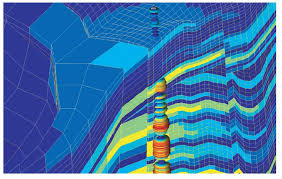Petrophysics and Logging are synonymous. Though Petrophysics is used in broader sense and encompasses Logging , Coring and many other things.
Logging is heart of Petrophysics.
By Logging we mean Data Acquisition.
After a Well is drilled logging team goes to drill site with computerised Unit and Logging tools.
Unit is equipped with a computer, various cards, interfaces between computer and logging tools and a Winch to lower the tools in the well and data is acquired about the formation below the surface.
Below surface formations are deposited in layers as sendiments brought by Rivers, Air, Glacier and sometimes reworked by Tidal waves.
Onshore (Onland) layers are mainly Shales and Sandstones. Sandstone is Hydrocarbon (HC) reservoir.
In Offshores Carbonates ( formed by deposition of microorganisms) are HC reservoirs. Logging tools record different sets of data from the bottom of a well upto surface, then they are analysed to find Sand layers, which may contain HC or Water. Log data first identify Sand layers , then it is checked with different sets of logs if they hold HC or not.
Some of the Logging tools which are lowered in a well to record data are :
1) Resistivity tools
a. Dual Induction Tool (DIL), used in oil
based mud.
b. Laterolog (LL) used in Saline mud
2) Porosity Tools
a. Density Tool
b. Neutron Tool
c. Sonic Tool
d. EPT Tool
3. Other Tools
a. Dipmeter Tool
b. RFT Tool
c. NMR Tool ( It is also used in hospitals, as CT Scan).
Original Oil In Place (OOIP ) is given by OOIP= 7758.A.h.(phie) (1-Sw)/Bo.
Sw = water saturation. calculated from Reistivity tool and porosity tool.
1-Sw = Oil saturation.
Bo = Formation Volume Factor, obtained from PVT studies.
Phie =Porosity. defined as pore vol.in a rock / Vol of Rock, expressed as fraction. Rocks below the surface of earth (say 3000m depth) look like Solid rock. They get solidified due to Overburden pressure.
Pressure due to rocks above the layer.
Still these rocks (all rocks) contain pore space inside them. Porosity expressed as % or fraction and varies from rock to rock. In class XI chemistry or physics we learn about Packing. Like in a f.c.c or h.c.p crystal structure packing is highest. And is 74%. What is rest 26 %?
It is Porosity. Rock porosity varies from rock to rock. h= height of a layer, we get from Logs (recorded data).
A = Area of a field. Calculated from extension of the field.
Let us see elaborately how it is done .
The first well drilled in an unexplored area is called Wild Cat Well. If Hydrocarbon is struck in the well, then wells are drilled in all directions away from the Wild Cat Well. These wells are called Exploratory Wells. If HC is struck in any direction(s) of these wells , then more wells are drilled away from the exploratory well In Steps. These wells are called Appraisal wells.
They are drilled till the boundary of the field is established. Once this is done Area of the field can easily be calculated.
And we get A.
Up to this is part of Exploration. For which Exploration license is to be obtained (PEL). After that economic ( cost benefit) analysis is done if Exploytation of HC to be started or not. If Yes, number of wells are drilled to put the field in Production. For which production license to be obtained. These wells are called Development wells. If production volume is more than expectations after say 5 years, then more wells are drilled for production. These are called Infill wells.
In next parts Logging tools and their principles and log analysis will be discussed.
(to be continued……)

Dr.GoutamMukhopadhyay, DOB 24.02.1954
B.Sc Physics Hons, Presidency College
M.Sc Physics C.U
Ph,d under Prof C.K.Majumadar, J.U
Diploma in Management from IGNOU
Joined ONGC in 1985, as Class I officer, as Petrophysicist
Retired in 2014
Served in data Acquisition , Processing and Interpretation
Visited Bogota, Colombia, in 2010 for data interpretation.
After retirement served ongc as domain expert, served Syntex oil as Consultant.
Delivered lectures on Petrophysics and other Petroleum subjects, Unconventional Energy,
Industrial Safety, Petroleum Refinery at different Institutes e.g MIT , Pune, ISM, Dhanbad,
RTU, Kota Rajasthan, SAL Institute , Ahmedabad, Petroleum Management University, Gandhinagar.
Last two years served Petroleum Department, Presidency University, Bangalore as Adjunct Faculty.






Comment here